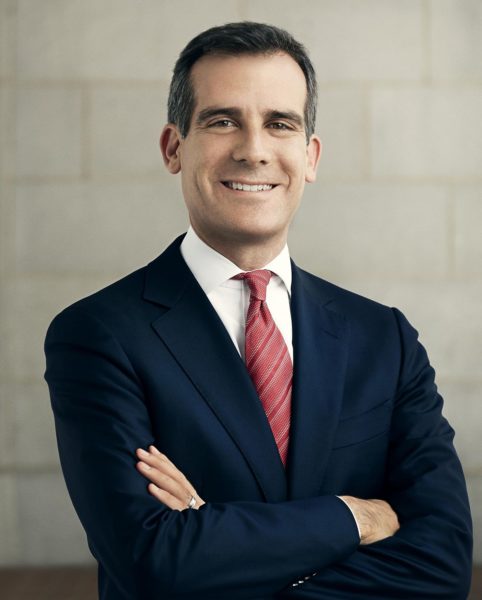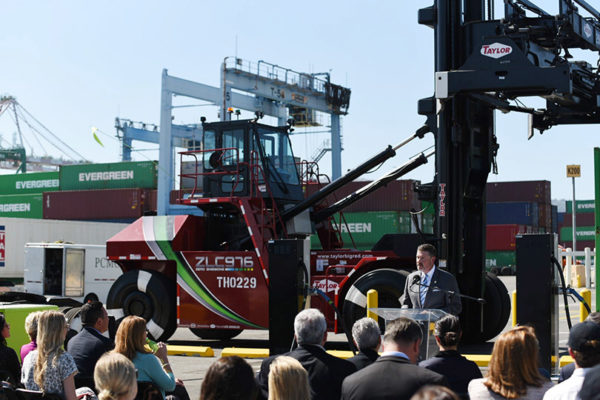Pioneering all-electric equipment advances clean cargo handling solutions
Clean cargo handling operations at the Port of Los Angeles are taking a giant leap forward with the demonstration of the world’s first zero-emissions top handlers. Joined by Los Angeles Mayor Eric Garcetti in celebration of California Clean Air Day, the Port today showcased two pre-commercial battery-electric top handlers that will be tested at the Everport Container Terminal.

“Every Angeleno deserves to know that future generations will inherit a sustainable city and a livable planet — and that our air, water, and natural resources will be protected and preserved,” said Mayor Eric Garcetti. “Clean Air Day gives L.A. an opportunity to show what it means to put our principles into practice with cleaner transportation, goods movement, and energy sources — to leave a healthier world for our children and grandchildren.”
“Today shows we are making good on our pledge to do the hard work of advancing commercially feasible solutions to meet our goal of transitioning all cargo handling equipment to zero emissions by 2030,” said Port of Los Angeles Executive Director Gene Seroka. “We’re excited to power up these battery-electric top handlers and test them under the real-world conditions of a working container terminal.”
The world’s first battery-electric top handlers were designed and built in the U.S. by Taylor Machine Works, Inc., a leading heavy-duty equipment manufacturer and the largest supplier of top handlers in service at the Port. Also known as top picks, top handlers are off-road vehicles with an overhead boom for loading containers weighing up to 75,000 pounds onto trucks and trains, unloading them, and stacking them on terminals between pickups and deliveries.

Taylor’s zero-emissions top handlers run on a one-megawatt battery designed to operate for up to 18 hours between charges. Each top handler has a data logger for tracking hours of operation, charging frequency, energy usage and other performance indicators.
The data collection process also involves obtaining feedback from all demonstration participants, including the drivers and mechanics who will operate and maintain the top handlers. Workers will be able to provide valuable input on the maneuverability, noise level and safety of the equipment.
The top handlers will be tested over a 12-month period, expected to begin by the end of the year. The Port and its partners will also evaluate the functionality of the connections and systems for charging the top handlers.
The battery-electric top handlers are a key component of the Port’s $7.7 million Everport Advanced Cargo Handling Demonstration Project. The California Energy Commission (CEC) is supporting the large-scale zero-emissions technology project with a $4.5 million sustainability grant.
“The CEC is proud to be working with forward-thinking partners like the Port of Los Angeles to accelerate the adoption of innovative and sustainable freight technologies,” said Energy Commissioner Patty Monahan. “Projects like this are critical to showcasing zero-emission equipment that can make the state’s freight industry more efficient and competitive, while helping clean California’s air.”
The Everport demonstration is one of 16 projects in which the Port is either the lead agency or a participant working with multiple partners to test near-zero emissions and zero-emissions engines, emissions control technology, and alternative fueling and charging stations. In addition to the battery-electric top handlers, the projects include testing hybrid natural gas and fully battery-electric fuel cell heavy-duty trucks; battery-electric forklifts, yard tractors, and rubber-tired gantry cranes; and emissions control equipment on large ships and harbor craft.
Taylor has decades of experience working with the Port’s marine container terminal operators to meet their equipment needs. Since the 2006 launch of the Clean Air Action Plan, the Mississippi-based manufacturer has played a key role in the Port’s air quality progress by helping terminal operators transition their top handlers to the cleanest available in today’s market. Currently, more than 60% of the 213 top handlers in Port service meet Tier 4 off-road diesel engine standards.
Eliminating tailpipe emissions from cargo handling equipment is essential to achieving the Port’s larger goal of reducing greenhouse gases (GHGs) from all port-related sources. Port targets call for reducing GHGs 40% below 1990 levels by 2030 and 80% below 1990 levels by 2050.
The Port of Los Angeles is America’s premier port and has a strong commitment to developing innovative, strategic and sustainable operations that benefit Southern California’s economy and quality of life. North America’s leading seaport by container volume and cargo value, the Port of Los Angeles facilitated $297 billion in trade during 2018. San Pedro Bay port complex operations and commerce facilitate one in nine jobs in the five-county Southern California region.











